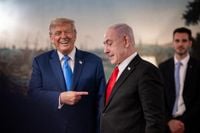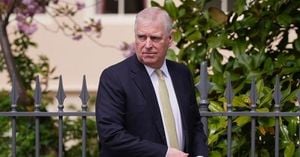In a dramatic turn of events, President Donald Trump has thrust himself into the center of the Gaza conflict, unveiling a sweeping 20-point peace plan that has set off a whirlwind of diplomatic activity, heated debate, and cautious hope across the Middle East. The proposal, announced on October 1, 2025, comes after a series of explosive developments—including a failed Israeli airstrike on Hamas leaders in Qatar—that have upended the region’s already volatile dynamics.
According to Axios, the roots of Trump’s plan stretch back to September 9, 2025, when Israel bombed Qatar in an unsuccessful attempt to assassinate senior Hamas figures. The strike, which missed its mark, had immediate and far-reaching consequences. Outrage erupted among Arab leaders, who united in condemnation of Israeli Prime Minister Benjamin Netanyahu. Inside Israel, public pressure mounted for a deal to release the remaining hostages and bring an end to the war in Gaza, which has raged since October 2023.
Trump’s advisers, Steve Witkoff and Jared Kushner, initially alarmed by the risk of regional destabilization, quickly recognized the crisis as a rare opportunity. "The Arabs were speaking with one voice," a Trump adviser told Axios. What began as a chorus of anger, they reasoned, could be redirected into collective action for peace.
Just a day before the Qatar strike, Witkoff and Kushner had met with Netanyahu’s trusted confidant, Ron Dermer, in Miami to discuss the Gaza peace process and possible scenarios for the region’s future. When news of the airstrike broke, they felt deceived—Dermer would later insist he hadn’t known of the operation in advance. Qatar, furious and feeling betrayed, immediately suspended its mediation efforts between Israel and Hamas and began rallying support against Israel throughout the region and beyond.
Several days later, Witkoff advised Dermer that the best way to defuse the crisis would be for Israel to apologize to Qatar and signal a genuine willingness to move toward peace in Gaza. Dermer, however, was not on board. But with Trump’s blessing, Witkoff and Kushner pressed ahead, crafting a 21-point proposal that blended the U.S. ceasefire and hostage-release framework with a post-war plan Kushner had previously developed alongside former British Prime Minister Tony Blair.
As the United Nations General Assembly approached in late September, Qatar floated the idea of a summit in New York. The aim: to bring Trump together with the leaders of eight Arab and Muslim countries to address the fallout from the Israeli strike and the ongoing war in Gaza. During the summit on September 30, Trump made his intentions clear. After reiterating his desire to end the conflict, he asked Witkoff to present the team’s plan. The reception in the room, according to Axios, was surprisingly positive.
By the following evening, the U.S. and the eight attending countries had reached a preliminary agreement on the text, which was then forwarded to Israel. Netanyahu met with Witkoff and Kushner in New York on October 2, but significant gaps remained. The next day, Netanyahu delivered a defiant speech at the UN—conspicuously omitting any mention of Trump’s peace plan. Behind the scenes, negotiations dragged on through the weekend, with both sides working feverishly to finalize the agreement before Netanyahu’s scheduled White House meeting with Trump on October 6.
As reported by The Independent, Trump was growing impatient. Over the weekend, he placed five stern phone calls to Netanyahu, issuing what one source described as a "take it or leave it" ultimatum. "Trump told Bibi in no uncertain terms: 'Take it or leave it. And leave it means we walk away from you,'" a source familiar with the conversation recounted. Trump made it clear that he expected a "clear yes" to the plan, not a "yes, but." He was willing to accept some Israeli edits—particularly those related to security—but drew the line at changes motivated solely by Netanyahu’s domestic political concerns.
By Sunday night, October 5, after hours of tense negotiations, Netanyahu finally conceded to several key terms, including the need to issue an apology to Qatar. The talks concluded at 11pm, with both sides having significantly narrowed their differences. "Netanyahu knew what he had to do. He didn't object. Give him credit: when he realized he had to do it, he did it," a source recalled to Axios.
Yet, as the latest draft was circulated to Arab and Muslim officials, new friction emerged. Many were incensed by the number of changes Netanyahu had managed to insert, especially regarding the terms of Israeli withdrawal from Gaza. "Bibi told Trump in their calls over the weekend that he won't just withdraw and let Hamas reconstitute," an Israeli official told Axios. Trump reportedly agreed with this stance, but the objections from Arab capitals were strong enough that the Qataris advised Trump’s team not to release the detailed plan just yet.
Trump, never one to be deterred by diplomatic caution, went ahead and published the plan anyway on October 6. He gave Hamas three to four days to respond. According to The Independent, White House spokeswoman Karoline Leavitt underscored the administration’s position: "We hope and we expect Hamas should accept this plan so we can move forward." She added, "It's a red line that the president of the United States is going to have to draw, and I'm confident that he will." Trump is counting on officials from Qatar, Egypt, and Turkey to help persuade Hamas to say yes.
But the path to peace is anything but clear. The BBC reported that mediators had reached out to Izz al-Din al-Haddad, the head of Hamas’s military wing in Gaza, who indicated he would not accept the U.S. plan. He reportedly believes the framework is designed to finish Hamas, regardless of whether the group agrees. The plan calls on Hamas to disarm and relinquish any future governing role in Gaza—terms that are deeply unpopular within the organization’s military ranks.
Some of Hamas’s political leaders in Qatar have shown openness to accepting the plan with adjustments, but their influence is limited, as they do not control the hostages still held by the group. As of early October, there are approximately 48 hostages in Gaza, with only about 20 believed to be alive. The plan requires all hostages to be released within the first 72 hours of the ceasefire—a stipulation Hamas sees as surrendering its sole bargaining chip.
Distrust runs deep. Hamas leaders cite the failed Israeli assassination attempt in Doha as proof that Israel cannot be trusted to uphold any agreement. They also object to the proposed deployment of a temporary International Stabilisation Force in Gaza, seeing it as a new form of occupation. Another sticking point is the "security buffer zone" along Gaza’s borders with Egypt and Israel, which remains vague and contentious, especially if Israel is involved in its administration.
Meanwhile, Netanyahu has sent mixed signals. While Israel has officially accepted the plan, Netanyahu has publicly insisted that the Israeli military will remain in parts of Gaza and that Israel will "forcibly resist" the creation of a Palestinian state—positions that contradict the U.S. framework’s call for a credible pathway to Palestinian self-determination and statehood.
The human cost of the conflict continues to mount. Since the war began with the Hamas-led attack on southern Israel on October 7, 2023—which killed about 1,200 Israelis and resulted in 251 hostages being taken—Israeli attacks have killed at least 66,225 people in Gaza, according to the territory’s Hamas-run health ministry. On October 1, 2025, Israeli airstrikes near the Nuseirat refugee camp once again displaced thousands of Palestinians, while Israeli authorities warned that anyone remaining in Gaza City would be considered a "terrorist or terror supporter," as reported by The Independent.
International reactions remain mixed. Russian President Vladimir Putin, speaking at the Valdai discussion club, remarked, "I think there may be light at the end of the tunnel," hinting at cautious optimism. But as the days tick down on Trump’s ultimatum, the fate of the peace plan—and of Gaza itself—hangs in the balance. All eyes are now on Hamas, Israel, and the region’s key mediators to see whether this latest push for peace will finally break the cycle of violence, or simply add another chapter to a long and bitter conflict.






